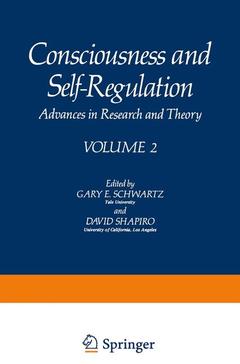Consciousness and Self-Regulation, Softcover reprint of the original 1st ed. 1978 Advances in Research and Theory VOLUME 2
Langue : Anglais
Auteur : Schwartz Gary

The first and foremost concrete fact which every one will affirm to belong to his inner experience is the fact that consciousness of some sort goes on. I -William James, 1893 We are witnessing today a mounting interest among behavioral and biological scientists in problems long recognized as central to our understanding of human nature, yet until recently considered out of the bounds of scientific psychology and physiology. Sometimes thrown into the heading of "altered states of consciousness," this growing research bears directly upon such time-honored questions as the nature of conscious experience, the mind-body relationship, and volition. If one broadly views this research as encompassing the two interrelated areas of consciousness and self-regulation, one can find many relevant contemporary examples of creative and experimentally sophisticated approaches, including research on the regulation of perception and sensory experience, attention, imagery and thinking, emotion and pain; hypnosis and meditation; biofeedback and volun tary control; hemispheric asymmetry and specialization of brain func tion; drug-induced subjective states; and biological rhythms. Because the material is spread over many different kinds of publications and disciplines, it is difficult for anyone person to keep fully abreast of the significant advances. The overall aim of the new Plenum Series in Consciousness and Self-Regulation: Advances in Research is to provide a scholarly forum for discussing integration of these diverse areas by presenting some of the best current research and theory.
1 The Human Brain and Conscious Activity 1.- 2 Imagery and Thinking: Covert Functioning of the Motor System.- I. Bodily Systems Implicated in Thought.- II. Neuromuscular Circuit Models of Thought.- III. Methodological Criteria.- IV. Empirical Studies.- V. The Curare Strategy.- VI. Stimulation, Surgical, and Clinical Strategies.- VII. Conclusions and Interpretation 83.- References.- 3 Regulation of the Stream of Consciousness: Toward a Theory of Ongoing Thought.- I. The Stream of Consciousness as a Psychological Problem: Arts and Sciences.- II. Psychoanalytic Approaches and the Notion of Regression.- III. Toward a Formulation of Ongoing Thought 105.- IV. Optimal Levels of Stimulation: A Cognitive-Affective View.- V. Some Research Prospects 128 References.- 4 Self-Deception, Self-Confrontation, and Consciousness.- I. Introduction.- II. Criteria Necessary and Sufficient for Ascribing Self- Deception.- III. Empirical Investigations of Self-Confrontation.- IV. The Experimental Investigation of Self-Deception.- V. Self-Deception, Functional Brain Asymmetry, and Consciousness.- 5 Visceroception, Awareness, and Behavior.- I. Visceroception and Psychophysics.- II. The Visceroceptive Threshold.- III. Visceral Discrimination.- IV. Visceral Perception.- V. Conclusions: The Possible Roles of Visceroception 209.- References.- 6 Stimulus-Bound Behavior and Biological Self- Regulation: Feeding, Obesity, and External Control.- I. Cues for Eating.- II. Individual Differences in Attention and Responsiveness to External Cues.- III. Generalizability of the Obesity-Externality Findings.- IV. Regulation and External Responsiveness.- V. The Internal-External Distinction 230.- References.- 7 Operant Conditioning of Autonomic Responses: One Perspective on the Curare Experiments.- I. Introductionand Background.- II. Some Experiments on Learning in the Curarized Rat.- III. The Case against Learning.- IV. Status of the Original Experiments.- V. Implications.- VI. Conclusion 310.- Appendix 312.- References.- 8 Acquired Control of Peripheral Vascular Responses.- I. Introduction: Scope and Issues.- II. Anatomy and Function of the Peripheral Vasomotor System.- III. Classical Conditioning of Vasomotor Responses.- IV. Instrumental Control of Vasomotor Responses.- V. Discussion 353.- References.- 9 On the Nature of Alpha Feedback Training 359.- I. Introduction.- II. Studies Suggesting Alpha Feedback Training May Influence Subjective Experience.- III. The Basic Alpha Feedback Experiments.- IV. Essential Refinements of Alpha Feedback Methods.- V. The Significance of the Visuomotor System for Alpha Feedback Training.- VI. Alpha and Arousal/Activation.- VII. Is Direct Awareness of Alpha Wave Production Possible? 387.- VIII. The Effects of Cognitive Activity on Alpha Dynamics.- IX. Overview and Prospects 396.- References.- 10 Passive Meditation: Subjective, Clinical, and Electrographic Comparison with Biofeedback.- I. Overview of This Chapter.- II. Biofeedback.- III. Passive Meditation.- IV. Electrographic Studies.- V. Overview of Clinical Indications.- VI. Summary 424.- References.- Author Index 429.
Date de parution : 11-2012
Ouvrage de 446 p.
15.2x22.9 cm
Thèmes de Consciousness and Self-Regulation :
Mots-clés :
© 2024 LAVOISIER S.A.S.



